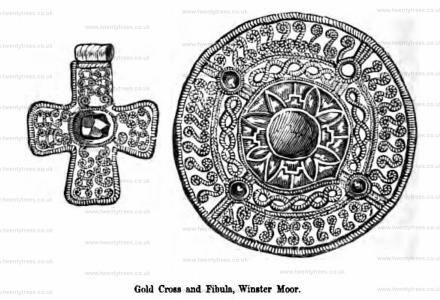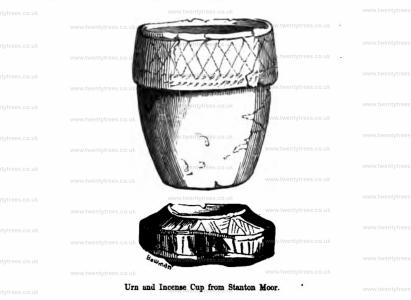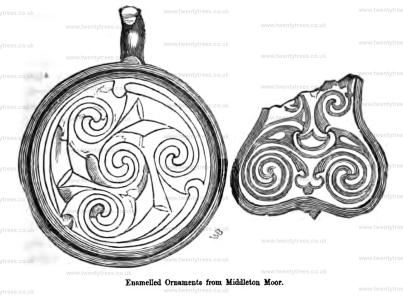Section I Tumuli 1759 to 1843
Section I Tumuli 1759 to 1843 is in Section I Tumuli.
Section I Tumuli 1759
Near Wardlow, a barrow [Map] [Wardlow Barrow 1 [Map]] was examined, in the year 1759, by the Rev. Mr. Evat, of Ashford. There were discovered in it about seventeen human bodies. These appeared to have been laid upon the surface of the ground, on long flat stones. They were inclosed by two side-walls, and the head and breast of each were protected from the incumbent weight of stone by a flat one laid over that part of the top. Two bodies near the middle of the barrow were walled up, and covered from head to foot, in the form of a long chest, with a stone cover to each. Jaw-bones, teeth, &c., were found undecayed, but none of the larger bones of the bodies. The barrow was thirty-two yards in diameter, and five feet high; the coffins or cells were two feet deep, and the complete ones were seven feet six inches long.
Section I Tumuli 1765
About a mile west of the village of Winster, on the right hand side of the road leading from that place to Pike Hall, once stood a barrow [Map], generally known by the name of White Lowe, which was destroyed in the year 1765 or 1766, by the farmer to whose share it fell, upon the inclosure of the common on which it was situate. On this occasion one of the most interesting and valuable discoveries ever made in the county was casually brought to light; and it is much to be regretted that no systematic account of it was written at the time, and correct draughts of the objects taken, which is now impossible, as one article alone exists of all the valuable deposit (now in the possession of Mr. John Mander, of Bakewell). Such is the dearth of information upon this subject, that little more than a list of the articles can be furnished; premising, however, that they were found in the centre of the barrow, and upon the level of the natural soil, whether in company with a skeleton or not there is no evidence. The list is as follows: two large globular urns, seventeen inches in height and about thirteen in circumference (quere diameter); two glass vessels, about nine inches in height, with wide circular mouths, and a slight bulge in the middle: they were made of yellow glass, extremely thin and light, and when discovered contained about a pint of clear green water; several variegated beads, square and round, both of glass and earthenware; a large bracelet of silver, about an inch broad, joining at the ends in dovetail fashion, and studded with human heads; figures of animals, &c., which were affixed by rivets; also a large circular fibula of gold, set with garnets, or red glass, which was strengthened by being riveted upon a plate of silver, which was assigned to the close of the fifth century by that distinguished antiquary the Rev. James Douglas. In the barrow the glass vessels were placed on each side of the urns, and the other ornaments were lying near them; around them were remains of decayed wood, and pieces of brass in the form of clasps and hinges, which would indicate that the more precious articles had been deposited in a box.
It is highly probable that a small cross of pute gold in the author's museum was discovered in the preceding barrow; the style of workmanship is almost identical with that of the circular fibula just mentioned. It is engraved as a vignette on page 67 of Douglas's 'Nenia Britannica' and by that learned antiquary is considered, notwithstanding its crucial form, to be of an era anterior to the introduction of Christianity into Britain. The only circumstances connected with its discovery that are now to be depended upon are these: it was found in the process of demolishing a tumulus on Winster Common, about the year 1767, and was bought from the labourer who was so fortunate as to find it by the Rev. John Mason, then curate of Winster, who had a taste for antiquities.

Section I Tumuli 1778
About 1778 or 1779, on removing a large heap of stones (a cairn?) a little east of Winhill Point, near Hope, an ill-baked urn, of rude workmanship, was found under it, standing on the surface of the ground, with the top covered with a flat stone.
Section I Tumuli 1782
At the summit of the eminence which rises above the little village of Chelmorton there are two considerable barrows, within a short distance of each other; the circumference of the larger one [Map] is nearly eighty yards, that of the smallest [Map] about twenty; on the top of each is a circular cavity or basin. A barrow, about the size of the former of these now mentioned, described by Pilkington as being situate about a quarter of a mile north-east from Chelmorton, was opened in the year 1782, by some labouring men who were searching for stone to build a walled fence in a neighbouring field. After removing a thin covering of moss and soil from the lower extremity of the mount or barrow, they discovered a kind of breastwork, or regular wall of single stones, formed without mortar; not apprehensive of meeting with anything extraordinary beyond this wall, they proceeded with their work, but were soon surprised with the sight of several human bodies; they found that the wall was at the end of a cell or coffin, in which the bodies had been deposited. The breadth of the cell within was two feet; but its depth was not fully ascertained, though supposed to be about a yard; the sides consisted of stones about eight inches thick and two feet wide; they were placed on their edge and formed a kind of partition: the stones used for the covering were from one to three inches thick, but not larger than the other. "Though some of the stones and a small quantity of soil had fallen into the vault, yet several human bodies or skeletons might be clearly distinguished, lying at full length, with, their heads towards the centre of the mount. The bones had never been disturbed, and were apparently united at the different joints, but by the slightest motion were found to be entirely loose and unconnected; upon examination they were discovered to be remarkably strong and sound: the ribs, in particular, were so little decayed that they would easily bend without breaking. Those who saw the bones thought that they were uncommonly large, and it was imagined that the persons to whom they belonged must have been, when alive, at least seven feet high; the teeth were sound and perfect. From the number of bones and skulls, and the dimensions of the vault, it was supposed that it contained about four or five human bodies, and though only one vault was opened, it was presumed that others were carried throughout the whole circumference of the mount, and might be about twenty in number."
Section I Tumuli 1787
About the year 1787, Major Booke opened a barrow [Note. It isn't clear which of the four Calton Barrows, Chatsworth [Map]: Calton Barrow 1 [Map], Calton Barrow 2 [Map], Calton Barrow 3 [Map] and Calton Barrow 4 [Map] is being referred to.] situate at the southern extremity of the earthwork at Calton, near Chatsworth, where he found an Urn of very coarse clay, slightly ornamented by zig-zag scratches, containing ashes of a light brown colour: it was found near the bottom of the tumulus, placed between two stones, set edgeways, and covered by a third; it measured near five inches in height, and near six in diameter at the mouth.
Towards the north-east end of Stanton Moor is a small Druid circle, inclosed with a vallum of earth and stones, not raised above two feet; within this at the west end was a little barrow [Map]; opened about the year 1787, by Mr. Rooke; this barrow was about six feet in diameter, and but slightly higher than the surrounding field. The Major here found three large urns of coarse clay, placed in a row, about eight inches from each other. They rested upon stones a little below the natural soil, within twelve or fourteen inches of the top of the barrow.
Seing so near the surface the heavy rains and the roots of fern and gorse which had so penetrated the urns, made it difficult to move them without their falling to pieces; in taking out of one of them the ashes and bones which it contained, the Major found at the bottom, a smaller urn, also full of burned bones, covered with a piece of clay of a circular form.
In 1799 Mr. White Watson, of Bakewell, procured several urns from tumuli, upon Stanton Moor, one of which with an incense cup found at the same place is here engraved. From the information of the person employed, it appears that three were frequently found in one barrow, arranged in a triangular form. Several other barrows were opened upon Stanton Moor by the Rev. Bache Thornhill, in which were discovered only such interments as had undergone cremation, and in most cases the ashes had been gathered together and placed within urns; the remains of three varieties of these vessels, with their contents, were presented by William Pole Thornhill, Esq., of Stanton, to the writer. Amongst the calcined bones were two pins, one of bone, the other of bronze, a few pieces of flint, and a large pebble with a vitrified surface resulting from the strong degree of heat to which in common with the other articles, it had been exposed.

More recently an entire human skeleton was found near an ancient bole or smelting-place for lead, in the same locality. Nothing remarkable is connected with this discovery, as any accompaniments that might have been deposited, were unnoticed at the time of the exhumation. The head of the femur is in a morbid state, being much diminished from its natural size, whilst the corresponding socket in the pelvis is filled up to an equally unnatural extent.
In the autumn of the year 1847, three urns were found in the same locality by persons engaged in cutting drains; they were about two feet beneath the surface, and appeared to have been baked upon the spot. They all contained human bones in a calcined state, and in one was found a small instrument of flint. When first discovered the largest one was inverted, and over the least of the two smaller, which stood upright, was placed a large stone.
Section I Tumuli 1788
On the 15th of March, 1788, a farmer, who occupied the land on Middleton Moor, known as the Garratt Piece, having occasion to burn some lime upon that ground, dug for the purpose into a tumulus [Map] [Garratts Piece Barrow [Map]], or lowe, there situate.
He began his work on the outer edge of the barrow, clearing it away as he proceeded, to the level of the natural surface. On reaching the centre, he found, lying immediately under the usual depression of the summit of the barrow, and placed upon the level of the ground, a skeleton, whose extremities were towards the east and west; near the point of the shoulder was a very extraordinary ornament of copper neatly enamelled with various colours, red being the most predominant; it is circular, and has a hook in the form of a serpent's head, probably for suspension. In addition to this, part of another ornament of similar workmanship; part of the iron umbo of a shield and a shallow basin of thin brass, much broken and crushed, were found abont the same place. (For a similar basin see Archæologia, vol. xviii, page 80.) The design visible upon the circular and enamelled ornament is precisely similar to an illuminated capital Q in the Saxon manuscript entitled, 'Textus Sancti Cuthberti,' a production of the seventh century, formerly preserved in the cathedral of Durham, but now in the Cottonian library, (Nero, D. 4.) There is a good engraving of it in Astle's 'Origin of Writing,' plate 14, a. This interesting barrow was reopened by Mr. William Bateman (age 1), on the 19th of June, 1826, but was found to have been entirely rifled on the occasion above described.

In the month of May, in the year 1787, a barrow was accidentally opened upon the moor near Middleton-by-Wirksworth, by a labourer getting stone for an inclosure, who, on arriving at the middle of the tumulus found a perfect skeleton extended on the ground, with an iron spear-head at his right hand. This weapon passed into the hands of Mr. Gell, the owner of the land, who subsequently discovered several other spears of the same shape, knives, and a quern, or hand mill-stone upon other parts of his property.
Section I Tumuli 1793
In May, 1793, Major Booke opened a large barrow on a rising ground near Hopton, which is called Abbotts Lowe [Map], and is about 196 feet in circumference. At the depth of about five feet from the top of the barrow was a very large urn, about seventeen inches in diameter, which was placed in an excavation in the native soil, about eighteen inches deep. It contained a deposit of burned bones and ashes, and was broken to pieces in attempting to remove it.
Section I Tumuli 1795
In the year 1795, two kistvaens, or British sepulchres, were discovered by Major Booke, on opening a large tumulus upon Fin-cop, about two miles north-west from Ashford. In one of these was a skeleton, with the face downwards, having a piece of the black Derbyshire marble, two feet long, nine inches wide, and six inches thick, lying on the skull; under the head were two arrow-heads of flint. The other contained burnt bones and ashes. In other parts of the tumulus were found three urns of coarse pottery, full of ashes and burnt bones, two skeletons, deposited on the level ground, and a spear-head of stone. In the same cist that contained the skeleton with the face downwards was found a small, flat, circular stone, which had a thin body of stucco on both sides; the top, which was of a yellowish colour, and had apparently been varnished.
Section I Tumuli 1827
In 1827 and 1828, Mr. Thomas Birds, of Eyam, opened several tumuli on Eyam Moor and on Leam Moor (adjoining), but never found anything more than rude urns and burnt bones. The barrows on Leam Moor, Abney Moor, and about High Lowe are very numerous, and many of them have been explored by Mr. John Oxley, of Sheffield (the then possessor of Leam Hall), Major Rooke, Mr. Samuel Mitchell (age 23), of Sheffield, and others, and many of them remain untouched. There are also numerous barrows upon Shalton Edge, overlooking Castleton and Hope. Some years ago some fragments of a very fine urn were found by a man engaged in planting, upon the side of Win Hill near to the summit. At the same time were found many ashes and some stags' horns.
Section I Tumuli 1834
In April 1834, Mr. Mitchell examined a tumulus on the Hathersage Moors adjoining the boundary of Bamford Common, upon which were recovered several rudely-shaped and sun-baked urns, which were filled with burnt bones, but no whole human bones occurred, and not the slightest appearance of rats' bones was noticed, which may be accounted for by the bodies Having been consumed previous to interment, and so presenting nothing tempting to the rats. This barrow was placed near to a Druidical circle.
The same gentleman, in 1826, opened several of the small tumuli in the vicinity of the "Cairs Work," or "Carls Wark [Map]," near Hathersage, and found them to contain nothing more than simple deposits of calcined bones, without the accompaniment of either urns or instruments. They may therefore be presumed to have been cast up at a very early period indeed. Shortly afterwards, Mr. Mitchell had an opportunity of opening a similar cluster of barrows on Broomhead Moors, in Yorkshire, close to the edge of Derbyshire, which displayed just the same features as those at the Carls Wark.